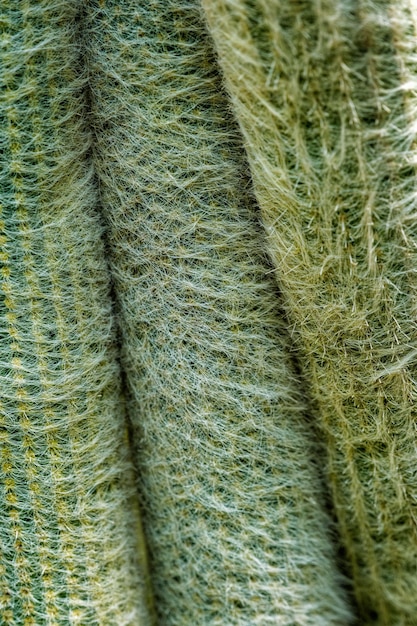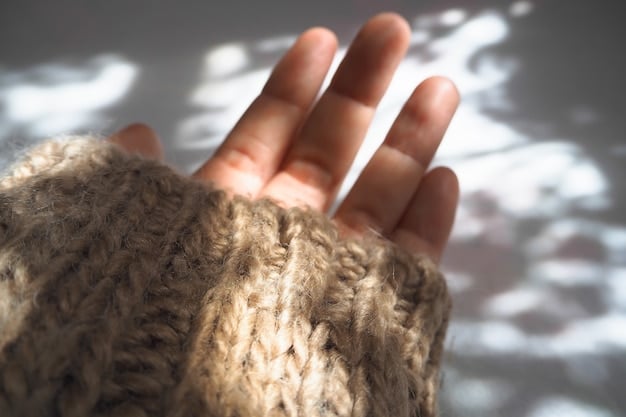Fall 2025 Knitwear: Cashmere vs. Merino vs. Alpaca – Which is Best?

Fall 2025 Knitwear Focus: Cashmere, Merino, and Alpaca offers a luxurious exploration into the world of premium fibers, guiding consumers through the unique benefits, care requirements, and ideal uses of each to make informed choices for their seasonal wardrobes, ensuring both comfort and style.
As the leaves begin to turn and a crispness fills the air, the thoughts turn to the cozy comfort of knitwear; the Fall 2025 Knitwear Focus: Cashmere, Merino, and Alpaca – Which is Right for You?, this guide dives into the softest and warmest fibers to elevate the seasonal wardrobe.
Understanding the Allure of Natural Fibers for Fall 2025
Natural fibers have long been cherished for their exceptional qualities, offering a unique blend of comfort, warmth, and luxurious appeal. As we transition into the cooler months of 2025, understanding the allure of these fibers becomes essential in making informed choices for our knitwear collections.
Cashmere, merino, and alpaca each possess distinct characteristics that contribute to their desirability. These fibers stand out due to their natural breathability, moisture-wicking capabilities, and unparalleled softness, making them ideal for creating garments that provide both comfort and style.
The Comfort Factor
The exceptional softness of natural fibers is a primary reason for their popularity. Cashmere, known for its ultra-fine texture, offers an incredibly gentle feel against the skin. Similarly, merino wool, with its fine fibers and smooth surface, avoids the itchiness often associated with traditional wool.
Warmth and Insulation
Natural fibers excel in thermal regulation, providing warmth without overheating. Cashmere boasts excellent insulation properties due to its crimped fibers, which trap air and create a barrier against the cold. Merino wool, with its natural crimp and elasticity, also offers superior warmth while remaining breathable.
- Cashmere: Renowned for its luxurious softness and excellent insulation.
- Merino: Known for its fine fibers, breathability, and non-itch properties.
- Alpaca: Appreciated for its durability, hypoallergenic qualities, and natural luster.
As we delve deeper into the world of natural fibers, it becomes apparent that their unique qualities make them a superior choice for fall 2025 knitwear. By understanding the distinctions between cashmere, merino, and alpaca, one can curate a wardrobe that embraces both comfort and style.

Cashmere: The Epitome of Luxury and Softness
When it comes to luxurious knitwear, cashmere stands in a class of its own. Celebrated for its unparalleled softness and delicate texture, cashmere has long been the fiber of choice for those seeking ultimate comfort and refinement.
Derived from the fine undercoat of cashmere goats, this exquisite fiber embodies elegance and sophistication, making it a coveted addition to any discerning wardrobe. Understanding cashmere’s unique characteristics and proper care is essential to preserving its luxurious appeal.
The Sourcing of Cashmere
Cashmere is primarily sourced from goats raised in regions with harsh climates, where the cold temperatures stimulate the growth of the soft undercoat. The harvesting process is delicate, involving combing the goats during the molting season to collect the fibers without causing harm.
Cashmere’s Unique Properties
Cashmere’s appeal lies in its ultra-fine fibers and their inherent qualities. The fibers are incredibly soft to the touch and provide exceptional warmth without bulkiness.
- Softness: Cashmere is unmatched in its delicate texture.
- Warmth: Provides excellent insulation without being heavy.
- Lightweight: Feels light and comfortable against the skin.
Proper care is essential to maintaining the softness and longevity of cashmere garments. Hand washing in cool water using a gentle detergent is recommended, as is laying flat to dry to prevent stretching or distortion.
Merino Wool: Versatility and Performance in Knitwear
Merino wool stands out as a versatile and high-performing fiber, combining natural comfort with practical benefits. Sourced from merino sheep, this exceptional wool is renowned for its fine fibers, breathability, and moisture-wicking capabilities, making it an ideal choice for a wide range of knitwear applications.
Whether you are seeking cozy warmth or performance-oriented activewear, merino wool offers a compelling blend of comfort and functionality. Understanding merino wool’s characteristics and versatility can assist in creating stylish and functional fall ensembles.
The Origins of Merino
Merino sheep, originally from Spain, are now primarily raised in Australia and New Zealand. The unique climate conditions in these regions, combined with selective breeding, have contributed to the development of merino wool with exceptional fineness and performance characteristics.
Benefits of Merino Wool
Merino wool boasts a combination of beneficial attributes, one of which involves how well it regulates moisture. The fine fibers of merino wool create a fabric that is naturally breathable.
- Breathability: Allows air to circulate, preventing overheating.
- Moisture-Wicking: Draws moisture away from the skin, keeping you dry and comfortable.
- Odor Resistance: Resists odor-causing bacteria, making it ideal for activewear.
Merino wool is celebrated for its versatility across different types of clothing. From base layers and activewear to sweaters and accessories, merino wool adapts to a variety of uses, providing comfort and performance in every application.
Alpaca Fiber: A Sustainable and Luxurious Choice
Alpaca fiber has emerged as a sustainable and luxurious choice for knitwear. Sourced from alpacas, gentle creatures native to South America, this remarkable fiber offers a unique combination of softness, warmth, and eco-friendly qualities.
As sustainability continues to gain prominence, alpaca fiber’s low environmental impact and exceptional properties make it an appealing option for conscious consumers and designers alike. Understanding the sustainable nature and luxurious attributes of alpaca fiber can assist in curating a wardrobe that emphasizes ethical choices.
Sustainable Farming Practices
Alpacas are known for their gentle grazing habits and soft footpads, which have a minimal impact on the environment.
Qualities of Alpaca Fiber
Alpaca fiber possesses noteworthy properties that underscore its popularity and desirability. It’s one of the softest natural fibers, similar to cashmere in its gentle feel against the skin.
- Hypoallergenic: Lacks lanolin, making it suitable for sensitive skin.
- Durable: Strong and resilient, ensuring long-lasting wear.
- Natural Luster: Possesses a natural sheen, enhancing its visual appeal.
Alpaca fiber’s versatile properties and low environmental impact are leading to its increased adoption in contemporary fashion. From sweaters and scarves to blankets and rugs, alpaca fiber lends its luxurious qualities to a variety of products.

Comparing Cashmere, Merino, and Alpaca: Key Differences
When choosing between cashmere, merino, and alpaca, understanding each fiber’s distinct characteristics can help tailor your knitwear selections to specific needs and preferences. Each fiber offers unique advantages in terms of softness, warmth, durability, and care requirements.
Comparing cashmere, merino, and alpaca across key criteria allows you to make informed decisions that align with your individual priorities. Whether you prioritize the ultimate luxury of cashmere, the versatile performance of merino, or the eco-friendly appeal of alpaca, this comparison provides valuable insights.
Softness and Comfort
Cashmere stands out as the softest of the three, offering an unmatched gentle feel against the skin. Merino wool is also exceptionally soft, with finer fibers compared to traditional wool. Alpaca fiber is soft and smooth, with a unique silky texture.
Warmth and Insulation
Cashmere provides excellent insulation due to its crimped fibers that trap air, offering substantial warmth. Merino wool offers good warmth while maintaining breathability. Alpaca fiber is known for its thermal properties, it keeps you warm in cold weather and cool in warmer conditions.
- Cashmere: Best for ultimate softness and luxurious feel.
- Merino: Best for combining comfort, breathability, and versatility.
- Alpaca: Best for sustainability, durability, and unique texture.
By assessing the characteristics of each fiber type, individuals can make knowledgeable choices that align with their lifestyles. Choosing the right fiber ensures that one’s knitwear offers the desired level of comfort, performance, and style.
Caring for Your Knitwear: Tips for Longevity
Proper care is essential for maintaining the beauty, softness, and longevity of cashmere, merino, and alpaca knitwear. Each fiber has specific requirements to prevent damage and preserve its unique qualities.
Adhering to best practices in washing, drying, and storage ensures that your cherished knitwear pieces continue to provide warmth and style for years to come. Learning how to care for knitwear ensures that valuable items last and always look their best.
Washing Techniques
Hand washing is generally recommended for cashmere and alpaca to protect the integrity of the fibers and prevent shrinkage. Merino wool can often be machine-washed on a gentle cycle, using cool water and a mild detergent.
Drying Methods
Laying knitwear flat to dry is crucial for maintaining its shape and preventing stretching. Avoid hanging wet items, which can cause the fabric to lose its structure and fit.
- Cashmere: Hand wash gently, lay flat to dry.
- Merino: Machine wash gentle cycle, lay flat to dry.
- Alpaca: Hand wash gently, lay flat to dry.
Storing knitwear properly helps protect fibers from moths, sunlight, and humidity. Fold items neatly and store them in a cool, dry place, away from direct sunlight. For cashmere and alpaca, consider using cedar chips or lavender sachets to deter moths.
| Key Point | Brief Description |
|---|---|
| 🐑 Merino Wool | Great for active wear due to breathability. |
| 🐐 Cashmere Softness | Known for the highest level of softness. |
| 🦙 Alpaca Qualities | Durable, hypoallergenic, environmentally sustainable. |
| 🍂 Fall 2025 | Choosing the right knitwear for the fall depends on your specific needs. |
Frequently Asked Questions
Cashmere is renowned for its excellent insulation, making it one of the warmest options for fall knitwear. Its fibers trap air, creating an effective barrier against the cold.
Yes, merino wool is often recommended for sensitive skin due to its fine fibers and smooth surface, which minimize irritation and itchiness compared to traditional wool. These attributes make it ideal for comfortable wear.
Hand washing in cool water with a gentle detergent is the best method for cleaning cashmere garments. Avoid wringing or twisting the fabric, and lay it flat to dry to preserve its shape and texture.
Alpaca farming is considered more sustainable due to the gentle grazing habits of alpacas. Alpacas cause less environmental impact than other livestock, and the fiber requires minimal processing.
Merino wool is an excellent choice for active wear because of its breathability and moisture-wicking properties. It helps regulate body temperature and keeps you dry and comfortable during physical activities.
Conclusion
Ultimately, the choice between cashmere, merino, and alpaca depends on individual preferences and intended use. Whether prioritizing ultimate luxury, versatile performance, or sustainable qualities, understanding the unique characteristics of each fiber ensures a well-informed and satisfying knitwear collection for Fall 2025.





